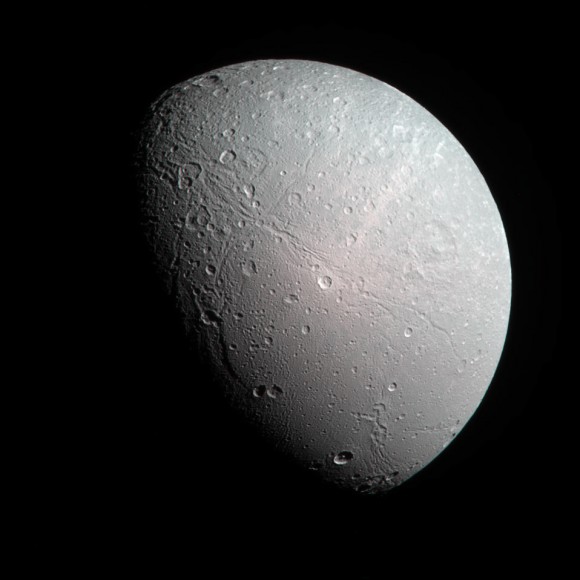Κάπου,
πολύ μακρυά από το γκρίζο μικρόκοσμο
της Διώνης του νεοπλουτισμού,
υπάρχει και μια άλλη
φασματική κοσμική Διώνη.

Color-composite of Dione made from raw Cassini images acquired on Dec. 23, 2012. (NASA/JPL/SSI. Composite by J. Major.)
700 miles (1120 km) wide, Dione is covered pole-to-pole in craters and crisscrossed by long, bright regions of “wispy line” terrain — the reflective faces of sheer ice cliffs and scarps that are too steep for darker material drifting in from Saturn’s E ring to remain upon.
The composite was assembled from raw images captured in red, green and blue visible light wavelengths by Cassini from a distance of 154,869 miles (249,238 km).
The view above looks at a region on Dione’s mid-northern hemisphere. The bright-walled crater in the center surrounded by warmer-hued terrain is named Creusa, and the long rift system next to it is Tibur Chasmata, which runs north-to-south. Dione’s north pole is to the upper left.
Dione’s heavily cratered areas are most common on its trailing hemisphere. Logically, a moon’s leading hemisphere should be the more heavily cratered, so it has been hypothesized that a relatively recent impact spun Dione around 180 degrees. The moon’s small size mean that even a modest-scale impact could have done the job.
Dione orbits Saturn at a distance of 209,651 miles (377,400 km), closer than our Moon is to us.
See more images and news from the Cassini mission here. And for more on Dione, see some of my previous posts on Lights in the Dark.
A graphic designer living in Providence, RI, Jason writes about astronomy and space exploration on his blog Lights In The Dark, Discovery News and here on Universe Today.
Δεν υπάρχουν σχόλια:
Δημοσίευση σχολίου
*** Τα ανώνυμα σχόλια δεν θα δημοσιεύονται πάντα. ***